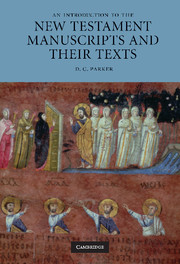Book contents
- Frontmatter
- Contents
- List of plates
- Links to URLs
- Acknowledgements
- List of abbreviations
- Introduction
- PART I THE DOCUMENTS
- PART II TEXTUAL CRITICISM AND EDITIONS
- 4 Manuscripts as tradents of the text
- 5 Textual criticism
- 6 Editions and how to use them
- PART III THE SECTIONS OF THE NEW TESTAMENT
- Glossary
- Index of manuscripts
- Index of biblical citations
- Index of names and subjects
4 - Manuscripts as tradents of the text
Published online by Cambridge University Press: 05 June 2012
- Frontmatter
- Contents
- List of plates
- Links to URLs
- Acknowledgements
- List of abbreviations
- Introduction
- PART I THE DOCUMENTS
- PART II TEXTUAL CRITICISM AND EDITIONS
- 4 Manuscripts as tradents of the text
- 5 Textual criticism
- 6 Editions and how to use them
- PART III THE SECTIONS OF THE NEW TESTAMENT
- Glossary
- Index of manuscripts
- Index of biblical citations
- Index of names and subjects
Summary
INTRODUCTORY
The interest hitherto has been almost totally on the manuscript as a physical entity. The focus now shifts to the texts which the manuscripts contain. That the text is found in manuscripts is not to be forgotten, and the bridge from the manuscripts to the text which best keeps the manuscripts in mind is a study of examples of copying. How accurate were scribes in making a copy? What sort of mistakes did they make? How significant were these mistakes? How many of them were mistakes, and how many intentional alterations? Which of their mistakes did they correct? What sort of corrections did subsequent readers make? In what ways do the physical characteristics of manuscripts cause textual change? How much did scribes alter texts, and how much was it readers who made changes and annotations? How may we observe and quantify these changes, and what sorts of comparisons do we draw between them? What models of scribal activity do we have, and how are these models dependent on our reconstruction of the writing process?
The wording in the title of this chapter is chosen because it does not include a reference to scribal activity. It is true that a scribe wrote down what is on the page. But unless we are able to compare what the scribe produced with the source manuscript, there are limitations to our understanding of scribal activity.
- Type
- Chapter
- Information
- An Introduction to the New Testament Manuscripts and their Texts , pp. 133 - 158Publisher: Cambridge University PressPrint publication year: 2008



